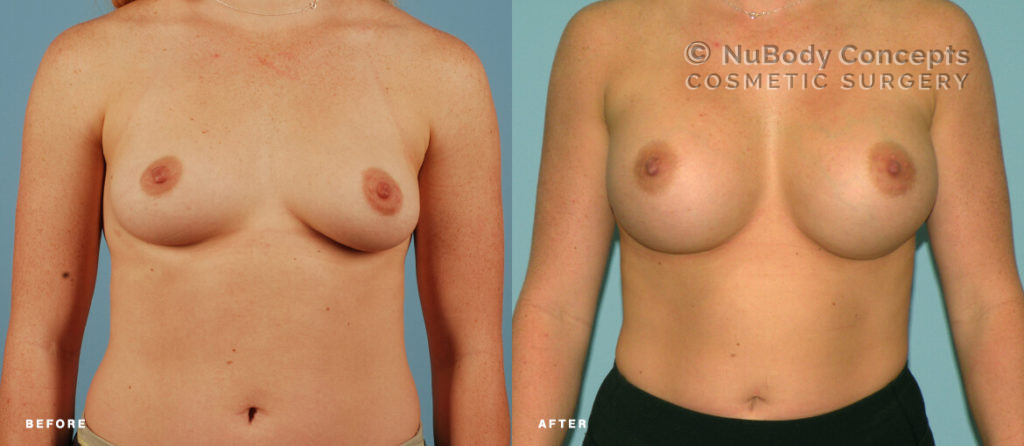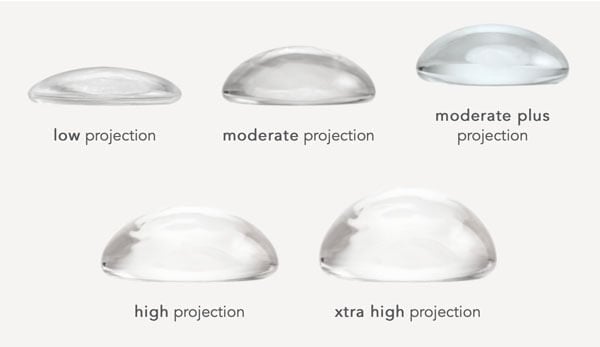
Medically reviewed by Dr. John Rosdeutscher – Written by Sine Thieme
When having a breast augmentation, selecting the implants that are best suited for you is one of the biggest decisions you’ll have to make. A variety of implants are available in different materials, shapes, and sizes. Your plastic surgeon will help determine which type is best suited to your needs and desired breast size.
Below we give an overview of the features of different types of breast implants.
Terminology
Breast Augmentation
A breast augmentation is the procedure a plastic surgeon performs to enhance a woman’s breasts. There are other types of breast surgery, such as a breast lift or breast reduction, but the term augmentation is typically used when an increase in volume is desired.
Breast Implants
Breast implants are the means – or material, if you wish – by which an increase in breast volume is achieved when a surgeon performs a breast augmentation. For the purposes of this article we use both terms interchangeably.
Breast Implants by Material
The two main materials breast implants are made of – or filled with – are silicone and saline. Both materials are FDA-approved.
Silicone Breast Implants
Silicone breast implants – the official term is silicone gel-filled breast implants, but they’re also referred to as gel-filled implants or cohesive gel implants – have a silicone outer shell that is filled with silicone gel. They come in different sizes and have either smooth or textured shells. Silicone implants have been approved by the U.S. Food and Drug Administration (FDA) for breast augmentation in women age 22 or older (with no age restriction for reconstruction cases).
Silicone implants feel and look more like natural breast tissue than saline implants, which makes them the most popular choice. They are also less likely to develop wrinkles or folds. As with any implant, there is a small chance that silicone gel-filled implants may leak. The cohesive gel is designed to remain within the implant shell, but some gel may happen to escape into the breast implant pocket. Regardless, a leaking silicone implant will not collapse.

Saline Breast Implants
Saline implants – the exact term is saline-filled breast implants – also contain a silicone outer shell but are filled with a sterile saltwater (saline) solution. They offer a uniform shape, firmness, and feel. They are inserted into the body empty and are then filled. Saline implants have been approved by the United States Food and Drug Administration (FDA) for breast augmentation in women age 18 or older (with no age restriction for reconstruction cases).
Saline breast implants may leak if ruptured, but this is harmless. In case of a leak, saline filled implants will collapse and the saline will be naturally absorbed and expelled by the body. Another benefit is that they allow for precise fine-tuning of volume, simply by adding more or less of the sterile solution.
While they provide less options for shape and may not have quite the same natural feel, saline implants remain popular due to their lower cost (on average up to $1,500 less than silicone implants) and their impeccable safety record.
Structured Saline Implants
This is a relatively new implant technology designed to give women the best of both worlds. Structured implants are saline-filled with all the advantages saline provides, but the inner construction into multiple chambers gives them more form and stability to mimic the natural look and feel of silicone implants.
The advantage of structured saline implants is the lower risks associated with rupture as well as capsular contracture, an outcome for some patients that typically requires revision surgery.
Breast Implants: Saline or Silicone?>>
Breast Implants by Shape, Texture & Projection
Round Implants
The most commonly used implants in the U.S. are round breast implants (available in both saline and silicone). They are the same shape all over and don’t typically run the risk of rotating out of place. They also offer more lift and a fuller appearance than form-stable implants (see below). You might choose a round implant to achieve greater projection – the distance measured from the chest wall forward.

Teardrop Shaped Implants
Teardrop shaped or tear-drop implants are shaped as the name implies: a narrower contour above and more fulness below the nipple.
Form-Stable Implants
Form-stable implants are made from a firmer type of silicone than regular gel-filled implants. This allows them to maintain their shape even if the implant shell becomes damaged or broken. In non-scientific terms they are commonly known as gummy-bear implants (because the highly cohesive silicone gel inside resembles the inside of a gummy bear). Tear-drop implants (see above) are a type of form-stable implant.
Highly-Cohesive Breast Implants (“Gummy Bear Implants”)
These are essentially the same as form-stable implants (see above). To create a stable form, a more cohesive, i.e. firmer, type of silicone gel is used.
In recent years gummy bear implants have become very popular but may not always be the best option for cosmetic surgery patients. Their firmness works particularly well for breast reconstructions where tissue has to be rebuilt, but may feel too firm for cosmetic breast augmentation patients. In addition, they require longer incisions on the skin than traditional silicone implants or saline implants.
The softness of regular silicone implants matches the natural bounce and texture of actual breast tissue more closely than gummy bear implants – making them a better choice in our opinion.
Smooth Implants
The shell of an implant holds the gel in place and can itself differ in structure. It can either be smooth or textured. Smooth implants are round and silky soft, and move naturally with the breast tissue.
Textured Implants
Textured implants can be “rougher” or “smoother” and are classified as macrotextured and microtextured accordingly. The texture allows the implant to adhere to the scar tissue that forms during healing. This holds the implant in place with the goal to minimize potential rotation.
Here is a table to help you understand the various groupings of breast implants:
| Implant Type | Other Names | Filling | Shape | Shell |
|---|---|---|---|---|
| Silicone implant | gel-filled implant, cohesive-gel implant | cohesive silicone gel | round | smooth |
| Highly-cohesive gel implant | gummy bear implant, teardrop-shaped implant, form-stable implant | highly-cohesive silicone gel | typically teardrop | typically textured |
| Saline implant | saline-filled implant | saline (sterile saltwater) | round | smooth |
| Structured saline implant | IDEAL implant (no longer manufactured as of 6/2023) | saline (sterile saltwater) | round | smooth |
Breast Implants by Size
This may come as a surprise, but implants are not measured in cup size like bras, but rather in cubic centimeters (cc). As a rule of thumb, for every 150-200 cc you can expect to go up one or one and a half cup sizes.
Most implants fall in the 300cc – 400cc range but can range all the way from 100cc to 800cc. What implant volume you choose will depend on your frame and lifestyle. If you want your breasts to look natural, your plastic surgeon can be of great help to make the size match your frame.
Stuck on a Cup? Here is How to Choose the Right Breast Implant Size>>
Breast Implants by Manufacturer
Our board-certified plastic surgeons at NuBody Concepts Nashville and Memphis use saline and silicone implants by Mentor and Sientra.
Types of Breast Augmentations
Most breast augmentations are routine surgeries where implants are placed above or below the muscle to increase volume. However, breast implants can also be used in slightly different surgeries.
Breast Implant Exchange
This involves removing a previous implant and replacing it with new implants. This could be due to a patient no longer desiring their current size or type of implants, the rupture of an existing implant, or some other imperfection like the emergence of ripples or a general deflation over the course of time (something more likely to happen with saline implants).
Capsulectomy
A capsulectomy is a procedure where a plastic surgeon removes abnormally thick and hardened tissue that in some cases forms around breast implants. This condition is also known as capsular contracture. During this procedure, the existing breast implant is removed and typically replaced with a new one.
We hope that our overview of breast implant types has served to give you a better understanding of how to choose the implant that is right for you. Please don’t hesitate to contact us if you have any other questions.
If you are ready to get started, use the pink button to schedule a consultation with our board-certified plastic surgeon in Nashville or Memphis.















